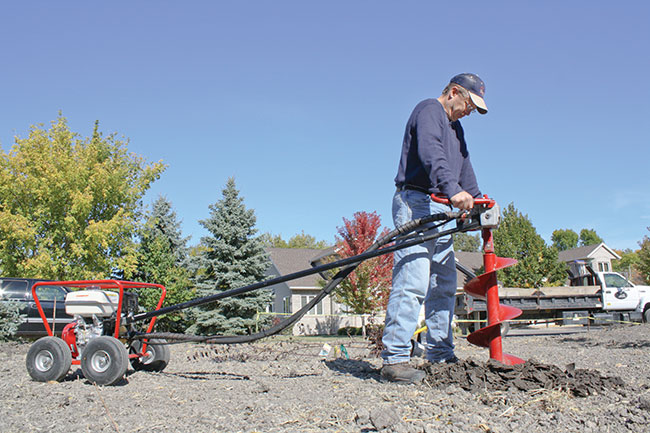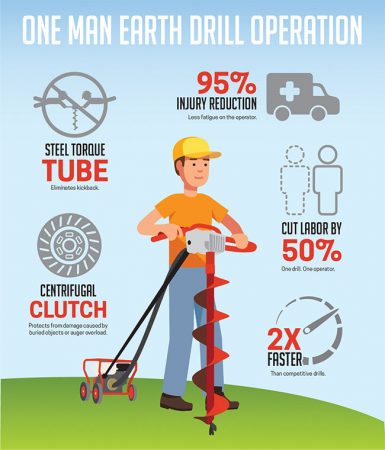
Features
Equipment
Turf Care Equipment
Enhancing your investment with one-person drills
Using a manageable one-person drill can save valuable time on work projects
December 18, 2020 By Mike Hale
 A one-person hole-digging operation is both safe and productive.
A one-person hole-digging operation is both safe and productive. At both the collegiate and professional level, great quarterbacks are few and far between, and for good reason. In addition to the hard work and dedication it takes to reach that level of competition, quarterbacks face a slim margin of error on every down. To complete a single pass, a quarterback must know the roles of defenders and anticipate their actions, account for the speed and timing of his receivers, and, of course, make a precise throw into a small and fleeting window of opportunity.
Running a small business can feel much the same. Between capitalizing on opportunities, attracting and retaining customers, hiring and motivating good employees, fending off the competition and managing expenses, the margin for error is small, at best.
Two of the most impactful variables affecting profits for business owners in the fencing and decking industries are labour and equipment costs. For this reason, discovering efficient and durable equipment that can also reduce labour costs is a game-changing play.
Managing manpower
For starters, wages, benefits and payroll taxes add up quickly, which is why labour is often a company’s largest expense. For fencing, decking and other high-volume hole digging businesses, taking a look at the equipment crews use to dig holes is one of the best ways to solve this issue and increase profits.
A lot of landscape contractors who offer fencing and decking use powerful, high-speed mechanical earth drills to dig holes. While mechanical drills provide high auger speeds – up to 360 rpm – for fast hole digging, they come with a major drawback. Many fail to protect operators from the torque and kickback associated with the drill’s power and speed and, as a result, require two operators to mitigate the risk of injury.
Two or three employees often make up an entire fence or deck crew, so when two are tied up digging holes, projects get off to a slow start. For many contractors this is the norm, but it doesn’t have to be. With equipment that allows for one-person digging, contractors can free up that second operator. Choosing wisely, however, is important, as there are several one-person digging solutions available, including skid steers, hydraulic drills and compact utility loaders. They all get the job done, but at the expense of efficiency, jobsite space and ease of manoeuverability, or all of the above.
Many contractors find the ideal solution to maximize their labour is with torque-free mechanical drills. These units accomplish high-speed digging and safe one-person operation through a unique design. The units’ engines are mounted on a separate carrier that attaches to the drill’s handles and drives the auger via a steel torque tube. This transfers the drill’s torque and kickback to the engine carrier, as opposed to the operator, making safe one-person operation with a compact drill possible.
The manageable size and efficient design of torque-free mechanical drills make it possible for contractors to reduce labour costs and complete jobs faster, increasing their capacity to take on additional work.
How it adds up
For a single residential fence project – an 80-by-40-foot standard backyard wood fence with eight-foot-long sections – approximately 20 holes are required. From unloading the drill to finishing the final hole, this portion of the job takes about an hour for two people to complete. With a one-person drill, however, the work can be completed in roughly half the time while the second person starts on other aspects of the project, such as unloading materials and placing posts.
Ultimately, this can shave as much as 30 to 45 minutes – more for larger jobs – off of the total time it takes to finish the project, so crews can move on to the next one faster. Although it may not sound significant, 30 minutes per job adds up quickly and can be enough to help a single crew complete an additional job or two every month. By the end of the busy season, a contractor with multiple crews can take on dozens of additional jobs, equating to thousands of dollars in revenue.
Even in areas where contractors do not have a backload of projects, completing each in less time reduces the cost of labour per job. If a two-person crew, for example, shaves 30 minutes off of each job, the contractor pays for an hour less of labour. At 15 dollars per hour, the contractor can reduce labour expenses by $50 to $100 per week, again adding up to thousands of dollars per year.
For smaller jobs, such as fence repair and sign installation, labour can be cut in half, since drilling is the only portion of the job requiring a second person. In addition to reducing the cost of labour required per job, torque-free drills help protect employees – as well as employers – from the burden of workplace injuries.

The benefits of one-person hole-drilling operations
Worker safety
On-the-job accidents and injuries remain common in manual labour professions. This results in employees missing work – eight days, on average – as they recover. With more serious injuries, employers also encounter costs associated with worker’s compensation claims.
While workplace injuries are not a new concern, it’s becoming increasingly important for employers to re-evaluate equipment that is more prone to causing sprains, strains and soreness. The fact is, the average age of the labour force in these industries continues to trend older. From 1998 to 2014, the proportion of workers who are 55 or older increased from 31.3 per cent to 40 per cent and is expected to continue to rise. Data also shows that as the average age of the workforce increases, the risk of injury goes up.
Another reason for employers to place a greater emphasis on user-friendly equipment is the role it plays in attracting younger employees who avoid manual labour jobs. By minimizing the physical stress on operators and reducing the likelihood of injuries, contractors can attract both older, more experienced workers as well as young employees.
In addition to employee safety, one-person mechanical rigs designed with features for durability and ease of operation can further chip away at labour costs.
Efficiency is profitability
Equipment repairs, inevitably, take time to complete, not to mention the downtime that can occur when a drill breaks down mid job. Even a basic repair, such as dull points and blades, can lead to as much as an hour of lost productivity between the crew members at the jobsite, as well as the time it takes for an employee to make the fix.
Features such as a heavy-duty transmission and centrifugal clutch, however, lessen the likelihood of untimely breakdowns. When drilling, it’s common to strike rocks, roots and other buried objects. If the auger hits an object, the centrifugal clutch releases, stopping rotation and preventing damage to both the auger and transmission.
Meanwhile, features such as snap-on augers and handle-mounted on/off switches also boost efficiency. Snap-on augers take employees seconds to change, while a conveniently located on/off switch can save the drill from unnecessary damage if it needs to be shut off quickly. These time-saving features further reduce the time it takes for crews to complete their work and move on to the next job.
Drilling down to the dollar
While quarterbacking a successful business is no easy task, finding solutions that increase the gap between revenue and ruin is a great way to ensure success. In industries that rely on earth augers, safe one-person drills provide exactly that.
Mike Hale started in the fence-building industry in 1974, and began working at Little Beaver Inc., a leading manufacturer of portable earth drills and accessories, in 1996. As the sales manager, he offers businesses his expertise on fence installation and hole digging equipment. He can be reached at mikeh@littlebeaver.com or at 800-227-7515.
Print this page